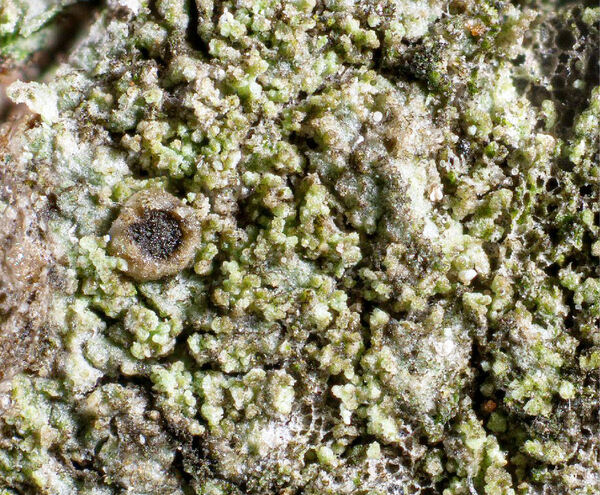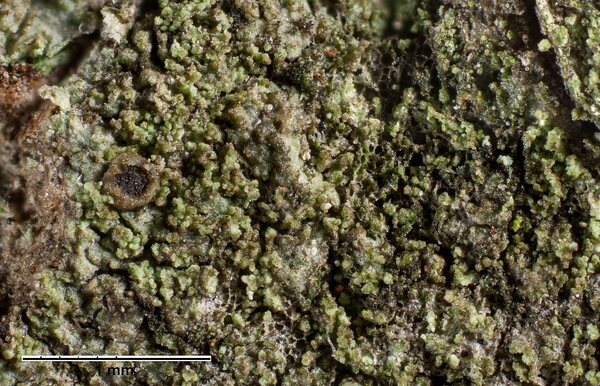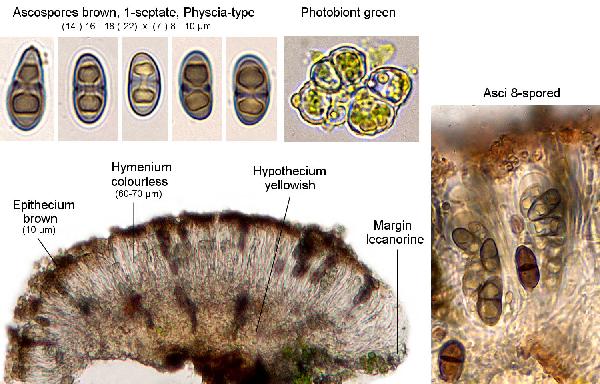Rinodina furfuracea H. Magn.
Meddel. Göteb. Bot. Trädg., 17: 236, 1947.
Synonyms:
Distribution: C - Sar (Giralt & al. 1995). S - Camp (Nimis & Tretiach 2004, Garofalo & al. 2010).
Description: Thallus crustose, thinly episubstratic, whitish, whitish brown or greenish, rarely delimited by a brownish prothalline line, more or less entirely blastidiate, the blastidia up to (12-)20-30 µm wide. Apothecia frequent, lecanorine, broadly attached, scattered to crowded, (0.4-)0.7-1(-1.5) mm across, with a flat to strongly convex, dark brown disc, and a thick, entire, prominent thalline margin which tends to become thinner, flexuose, often blastidiate, and finally completely excluded. Thalline exciple (50-)65-90 µm wide laterally, indistinctly corticate; proper exciple 10-15 µm wide laterally, expanded to 35-40 µm in upper part; epithecium brown, K-; hymenium colourless, (70-)80-100 µm high; paraphyses 1.5(-2) µm thick at mid-level, the apical cells 3-5 µm wide; hypothecium yellowish, 100-110 µm high. Asci 8-spored, clavate, the K/I+ blue tholus penetrated by a faintly amyloid apical cushion with parallel or diverging flanks, the wall K/I-, surrounded by a K/I+ blue outer layer, Lecanora-type. Ascospores 1-septate, brown, ellipsoid, (12-)14-17(-20) x (6.5-)7-9(-11) µm, Physcia-type tending towards the Physconia-type, with a well-developed torus, constricted at septum, with a warted wall when mature, the ontogeny of type A (apical wall thickening after the early septum formation). Photobiont chlorococcoid. Spot tests: thallus K-, C-, KC-, P-, UV-. Chemistry: without lichen substances.Note: a Mediterranean-Atlantic lichen restricted to coastal localities with frequent humid, salt-laden winds, e.g. on Juniperus on sand dunes, but also in very humid deciduous forests far from the coast. It is included in the Italian red list of epiphytic lichens as “Endangered” (Nascimbene & al. 2013c).
Growth form: Crustose
Substrata: bark
Photobiont: green algae other than Trentepohlia
Reproductive strategy: mainly asexual, by isidia, or isidia-like structures (e.g. schizidia)
Most common in areas with a humid-warm climate (e.g. most of Tyrrenian Italy)
Taxon bound to maritime-coastal situations
Commonnes-rarity: (info)
Alpine belt: absent
Subalpine belt: absent
Oromediterranean belt: absent
Montane belt: absent
Submediterranean belt: absent
Padanian area: absent
Humid submediterranean belt: extremely rare
Humid mediterranean belt: extremely rare
Dry mediterranean belt: absent

Predictive model
Herbarium samples
Growth form: Crustose
Substrata: bark
Photobiont: green algae other than Trentepohlia
Reproductive strategy: mainly asexual, by isidia, or isidia-like structures (e.g. schizidia)
Most common in areas with a humid-warm climate (e.g. most of Tyrrenian Italy)
Taxon bound to maritime-coastal situations
Commonnes-rarity: (info)
Alpine belt: absent
Subalpine belt: absent
Oromediterranean belt: absent
Montane belt: absent
Submediterranean belt: absent
Padanian area: absent
Humid submediterranean belt: extremely rare
Humid mediterranean belt: extremely rare
Dry mediterranean belt: absent

Predictive model
| Herbarium samples |
 INDEX FUNGORUM
INDEX FUNGORUM
 GBIF
GBIF





